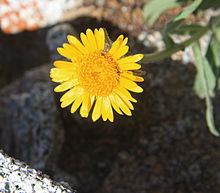Higher classification Hulsea | Scientific name Hulsea algida Rank Species | |
 | ||
Similar Hulsea, Daisy family, Ericameria discoidea, Polemonium eximium, Chaenactis douglasii | ||
Hulsea algida is a species of flowering plant in the daisy family, known by the common name Pacific hulsea or alpine gold.
Hulsea algida is native to California, Oregon, Nevada, Idaho, Montana, and Wyoming. Within California, it grows in the Sierra Nevada and in the White Mountains. It grows between 9,500 and 14,000 feet (2,900 and 4,300 m) in elevation, in alpine and subalpine talus habitats.
Description
Hulsea algida is a hairy, glandular perennial herb producing stout erect stems approaching 40 centimeters (16 inches) in height. The dark green leaves are narrow and covered in white hairs, and the edges are wavy and toothed. Most of the leaves occur in a thick patch at the base of the plant and some grow from the stems.
The flower head is encased in a cup of densely woolly reddish green phyllaries which open to reveal a daisy-like bloom one to three centimeters (0.4-1.2 inches) across. The center of the head is filled with yellow or orange disc florets and the circumference has up to 60 bright yellow or gold ray florets each about a centimeter (0.4 inches) long with rounded or toothed tips.
The fruit is an achene up to a centimeter long with a pappus which may be longer.
